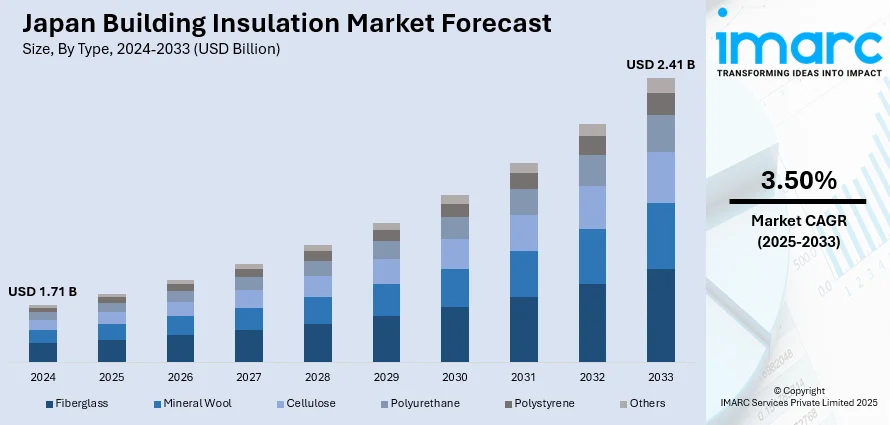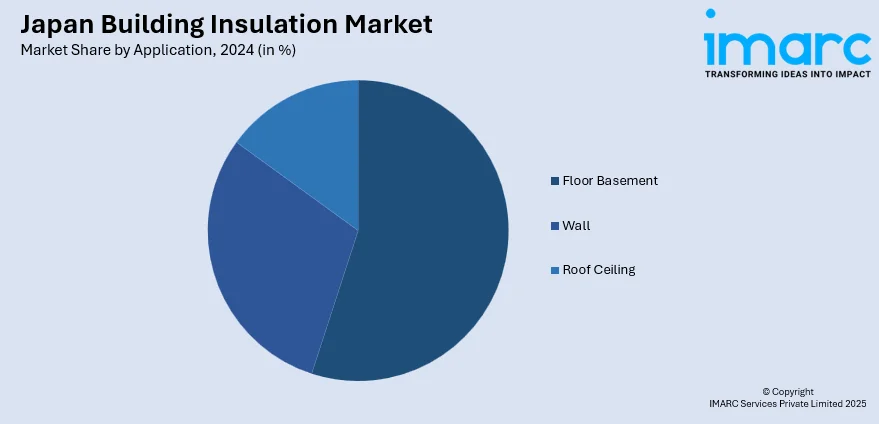
Japan Building Insulation Market Size, Share, Trends and Forecast by Type, Application, End User, and Region, 2025-2033
Japan Building Insulation Market Overview:
The Japan building insulation market size reached USD 1.71 Billion in 2024. Looking forward, IMARC Group expects the market to reach USD 2.41 Billion by 2033, exhibiting a growth rate (CAGR) of 3.50% during 2025-2033. At present, as urbanization activities are increasing, the number of new residences, workplaces, and public structures is growing, each requiring appropriate insulation for effective heating and cooling. Besides this, rising utility costs, which are encouraging the adoption of high-performance materials that provide better thermal resistance, are contributing to the expansion of the Japan building insulation market share.
|
Report Attribute
|
Key Statistics
|
|---|---|
|
Base Year
|
2024
|
|
Forecast Years
|
2025-2033
|
|
Historical Years
|
2019-2024
|
| Market Size in 2024 | USD 1.71 Billion |
| Market Forecast in 2033 | USD 2.41 Billion |
| Market Growth Rate 2025-2033 | 3.50% |
Japan Building Insulation Market Trends:
Rising construction activities
Increasing construction activities are positively influencing the market in Japan. As cities are expanding and infrastructure projects are growing, builders are focusing on integrating insulation to meet energy-saving standards and improve indoor comfort. New buildings often require compliance with stricter regulations that emphasize thermal performance and sustainability. This is encouraging developers to adopt advanced insulation solutions during the construction phase. With rising urbanization activities, the number of new homes, offices, and public buildings is increasing, each requiring proper insulation for heating and cooling efficiency. This shift towards green buildings and eco-friendly design is enabling the adoption of high-performance insulation systems. Moreover, construction in colder regions of Japan is creating the need for effective insulation to reduce energy usage and maintain thermal comfort. Construction companies prefer modern insulation materials that are easy to install and offer long-term savings. The increased activity is also benefiting suppliers and manufacturers of insulation products, boosting local production and innovations. Public and private investments in infrastructure projects like hospitals, schools, and transportation hubs are adding further momentum to the market. Consequently, the continuous expansion of construction activities is supporting the expansion of building insulation systems across Japan, promoting energy optimization, comfort, and environmental responsibility. According to industry reports, the Japan construction market is set to grow from USD 609.27 Billion in 2024 to USD 716.66 Billion by 2029, exhibiting a compound annual growth rate (CAGR) of 3.30% during the forecast period.

Increasing electricity costs
Rising electricity costs are impelling the Japan building insulation market growth. According to the CEIC, in November 2024, Japan's electricity production reached 62,523 GWh. As electricity prices are increasing, more people are looking for ways to reduce their power usage, and insulation is becoming a key solution. Proper insulation helps maintain indoor temperatures, lowering the need for constant heating and cooling. This leads to minimized energy bills and more stable indoor environments. Building owners are becoming more aware about long-term savings and prefer insulation upgrades to control operating costs. Energy-efficient buildings are also gaining higher property value, encouraging investments in insulation during both new construction and renovation. In urban areas with dense populations and high energy utilization, insulation offers significant benefits in reducing overall demand. Rising utility costs are also encouraging the adoption of high-performance materials that provide better thermal resistance. Government policies supporting energy savings align with this trend, offering incentives that are further driving the demand. Commercial buildings, factories, and schools are turning to insulation as a cost-saving strategy. As electricity prices continue to rise, the need for effective insulation is growing, making it an essential component in energy-conscious building design throughout Japan.
Japan Building Insulation Market Segmentation:
IMARC Group provides an analysis of the key trends in each segment of the market, along with forecasts at the country and regional levels for 2025-2033. Our report has categorized the market based on type, application, and end user.
Type Insights:
- Fiberglass
- Mineral Wool
- Cellulose
- Polyurethane
- Polystyrene
- Others
The report has provided a detailed breakup and analysis of the market based on the type. This includes fiberglass, mineral wool, cellulose, polyurethane, polystyrene, and others.
Application Insights:

- Floor Basement
- Wall
- Roof Ceiling
A detailed breakup and analysis of the market based on the application have also been provided in the report. This includes floor basement, wall, and roof ceiling.
End User Insights:
- Residential
- Non-Residential
The report has provided a detailed breakup and analysis of the market based on the end user. This includes residential and non-residential.
Regional Insights:
- Kanto Region
- Kansai/Kinki Region
- Central/ Chubu Region
- Kyushu-Okinawa Region
- Tohoku Region
- Chugoku Region
- Hokkaido Region
- Shikoku Region
The report has also provided a comprehensive analysis of all the major regional markets, which include Kanto Region, Kansai/Kinki Region, Central/Chubu Region, Kyushu-Okinawa Region, Tohoku Region, Chugoku Region, Hokkaido Region, and Shikoku Region.
Competitive Landscape:
The market research report has also provided a comprehensive analysis of the competitive landscape. Competitive analysis such as market structure, key player positioning, top winning strategies, competitive dashboard, and company evaluation quadrant has been covered in the report. Also, detailed profiles of all major companies have been provided.
Japan Building Insulation Market News:
- In November 2024, a research group, headed by Assistant Professor Wataru Umishio from the Institute of Science Tokyo, explored the cost-effectiveness of residing in well-insulated warm homes to avert CVDs by examining houses in Japan with varying thermal insulation and indoor temperatures. It was found that the healthy life expectancy for couples rose by 0.31 QALYs. The incremental cost-effectiveness ratio (ICER) remained below Japan's threshold of JPY 5 Million per QALY, suggesting that the health benefits justified the costs of upgrading.
Japan Building Insulation Market Report Coverage:
| Report Features | Details |
|---|---|
| Base Year of the Analysis | 2024 |
| Historical Period | 2019-2024 |
| Forecast Period | 2025-2033 |
| Units | Billion USD |
| Scope of the Report |
Exploration of Historical Trends and Market Outlook, Industry Catalysts and Challenges, Segment-Wise Historical and Future Market Assessment:
|
| Types Covered | Fiberglass, Mineral Wool, Cellulose, Polyurethane, Polystyrene, Others |
| Applications Covered | Floor Basement, Wall, Roof Ceiling |
| End Users Covered | Residential, Non-Residential |
| Regions Covered | Kanto Region, Kansai/Kinki Region, Central/Chubu Region, Kyushu-Okinawa Region, Tohoku Region, Chugoku Region, Hokkaido Region, Shikoku Region |
| Customization Scope | 10% Free Customization |
| Post-Sale Analyst Support | 10-12 Weeks |
| Delivery Format | PDF and Excel through Email (We can also provide the editable version of the report in PPT/Word format on special request) |
Key Questions Answered in This Report:
- How has the Japan building insulation market performed so far and how will it perform in the coming years?
- What is the breakup of the Japan building insulation market on the basis of type?
- What is the breakup of the Japan building insulation market on the basis of application?
- What is the breakup of the Japan building insulation market on the basis of end user?
- What is the breakup of the Japan building insulation market on the basis of region?
- What are the various stages in the value chain of the Japan building insulation market?
- What are the key driving factors and challenges in the Japan building insulation?
- What is the structure of the Japan building insulation market and who are the key players?
- What is the degree of competition in the Japan building insulation market?
Key Benefits for Stakeholders:
- IMARC’s industry report offers a comprehensive quantitative analysis of various market segments, historical and current market trends, market forecasts, and dynamics of the Japan building insulation market from 2019-2033.
- The research report provides the latest information on the market drivers, challenges, and opportunities in the Japan building insulation market.
- Porter's five forces analysis assist stakeholders in assessing the impact of new entrants, competitive rivalry, supplier power, buyer power, and the threat of substitution. It helps stakeholders to analyze the level of competition within the Japan building insulation industry and its attractiveness.
- Competitive landscape allows stakeholders to understand their competitive environment and provides an insight into the current positions of key players in the market.
Need more help?
- Speak to our experienced analysts for insights on the current market scenarios.
- Include additional segments and countries to customize the report as per your requirement.
- Gain an unparalleled competitive advantage in your domain by understanding how to utilize the report and positively impacting your operations and revenue.
- For further assistance, please connect with our analysts.
 Request Customization
Request Customization
 Speak to an Analyst
Speak to an Analyst
 Request Brochure
Request Brochure
 Inquire Before Buying
Inquire Before Buying




.webp)




.webp)












